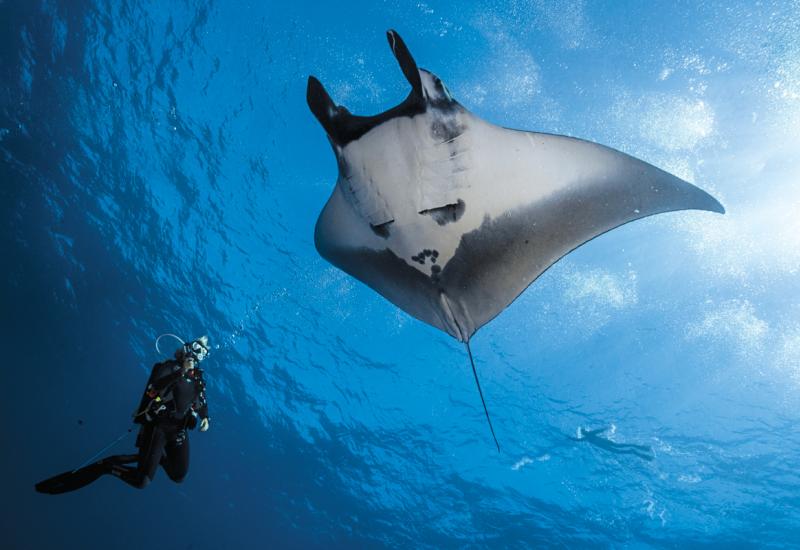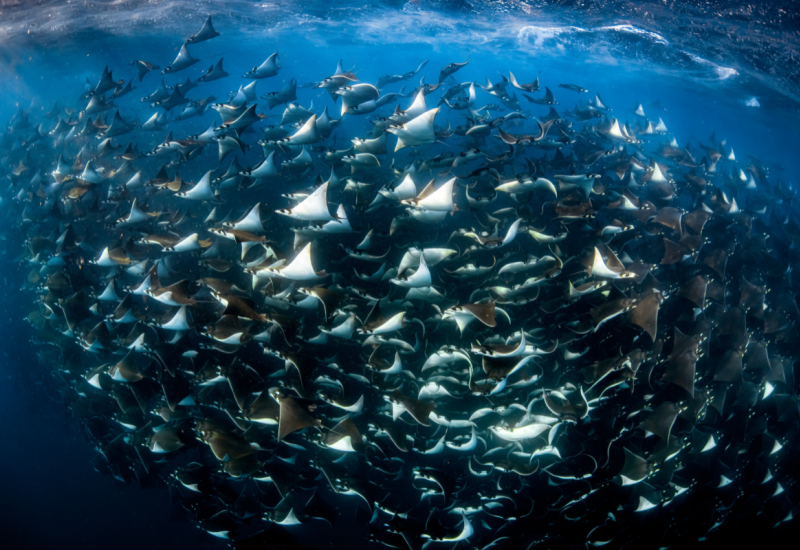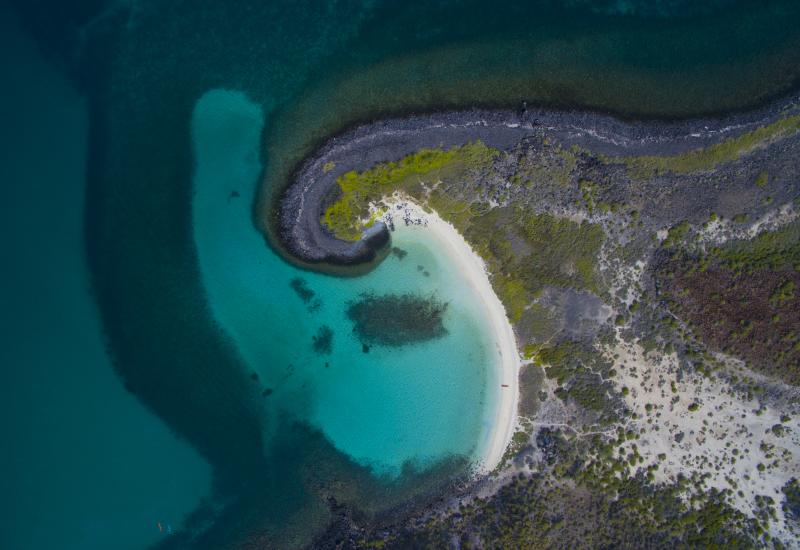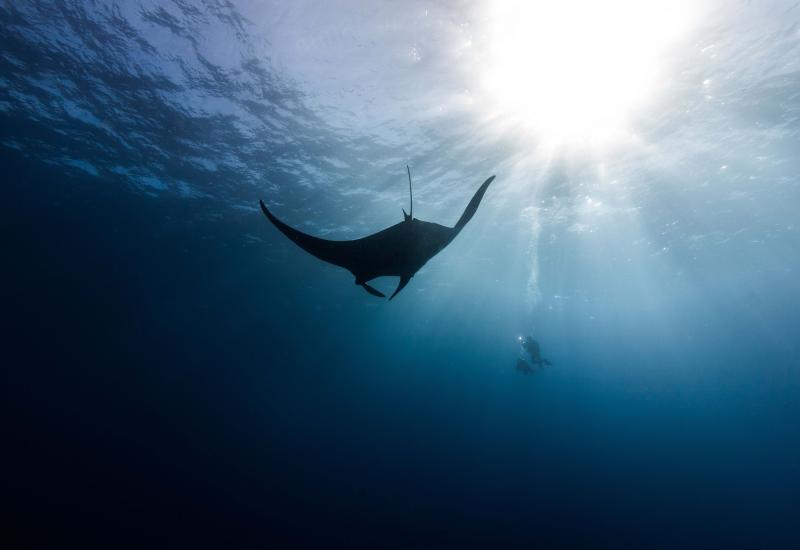Baja & Sea of Cortez
 |
| Mantas, often seen with wingspans greater than 15 feet, are the encounter of choice among divers traveling to Baja. |
Cross over the U.S. border below the California state line and you've entered the great Baja peninsula. It is a land of vast, dry desert studded with cardon cactus and pine-rich rock mountains. Heart-stopping underwater encounters await you on sites surrounding the many uninhabited wind-raked islands dotting the coastline. The plankton-rich currents of the Pacific along the western coast of California Sur and sheltered waters of the Sea of Cortez support whale sharks, dolphins, giant manta rays and schools of sharks such as scalloped hammerheads.
La Paz and Loreto on the southern interior and Los Cabos (Cabo San Lucas and San Jose Del Cabo) at the southern tip are the staging areas for expeditions to dive with the same sharks and rays that draw divers to exotic locales like Cocos Island and the Galapagos. Out in the deep, 220 miles southwest of Cabo, the Socorro island chain, also known as Islas Revillagigedo, is an uninhabited archipelago that offers tremendous diving on its lava-forged flanks.
Loreto
Midway up the east coast of the peninsula, Loreto sits perched in the shadow of the Sierra Giganta mountains. The town of 10,000 is little more than a sleepy, seaside community, but divers have long boarded boats headed to the nearby islands of Coronado, Carmen, Danzante, Monserrate and Catalan. Like most of these island sites, the marine habitat encompassing them was protected by the designation of the Parque Maritimo Nacional Bahia de Loreto in 1997.
The underwater cliffs of Los Candelleros, a triad of rocky mounts to the east of Danzante, drop precipitously to a rocky bottom at 200 feet.
Down for 20 years, the 120-foot tuna boat in Bahia Salina Bay rests at 35 feet near the site of Carmen's now defunct salt plant. Out in Escondido Bay, Punta Coyote is a quick panga ride from shore. The rock bottom is strewn with boulders, most with settlements of sea fans, gorgonians and their attendant schools of balloonfish.
 |
| Yellowfin tuna are often found schooling at offshore seamounts in the Sea of Cortez and at sites surrounding the Socorro Islands. |
La Paz
A favorite beach destination of Mexicans, La Paz, hub of Baja eco-tourism, affords some of the best diving in the Sea of Cortez. There is a diversity of options: a shipwreck dive, a chance to swim alongside sea lions and the likelihood of shark encounters at the seamounts.
The 300-foot-long ferry Salvatierra became an artificial reef by accident, grounding on Swanee Rock in San Lorenzo channel in 1975. Cargo, like the trucks that were en route from La Paz to Topolobampo, rest alongside the former World War II transport ship at 60 feet. Cortez angelfish, jewel morays and groupers are common not far from her still-intact props.
With her backdrop of sharp monolithic rocks, Los Islotes, on the north side of Isla Partida, has been colonized by sea lions. An archway cut through the island on the eastern end is a popular night dive, rife with cocooned parrotfish, king angelfish and billowing orange cup corals.
Rising up to within recreational limits, the Pinnacles and Seamount of Las Animas as well as El Bajo Seamounts attract schooling jacks, tunas and hammerheads. Boat trips are not quick jaunts, so operators favor making a two-tank outing a day trip with lunch.
Socorro Islands
The volcanic chain of Socorro, San Benedicto, Roca Partida and Clarion islands is reachable only by live-aboards and other vessels capable of handling the 24-hour crossing from Cabo. Strong currents, plankton-rich upwellings and underwater promontories characterize the diving in this protected string of islands.
November through June is the optimal dive season thanks to the most manageable conditions, but currents and surge are common even then. While visibility can top 100 feet, pockets of plankton can cloud the water.
With drum-beating wings, giant mantas glide through the waters surrounding Benedicto's seamounts like the Boiler. Galapagos, silvertip, silky and hammerhead sharks frequent Bruce's Site, a seamount on the eastern side of Benedicto in full view of her volcanic cone.
Along with San Benedicto, Socorro, centerpiece of the islands, is a southerly reference point along the spring humpback migration. Less imposing than these great mammals, creatures like clarion angelfish, redtail triggerfish and Moorish idols appear at Socorro sites between Double Pinnacle and North End.
 |
| Rocky islands like Los Islotes off La Paz and Pinnacle off Los Cabos have been adopted by colonies of sea lions because of the abundance of fish life. |
Los Cabos
 |
| Schools of Panamic sergeant majors and barberfish intermingle on a Baja reef. |
Don't allow the beachfront high-rises and boomtown atmosphere of Cabo San Lucas and San Jose Del Cabo color your impression of the diving. There is much to be seen here in addition to the barren rocks of the Land's End arches where the Sea of Cortez commingles with the cold Pacific.
Credit Jacques Cousteau with the discovery of Sand Falls, a barren plain at 90 feet where sands shift over a rock wall. Nearby Anegada Rock, which the boats pass en route to Sand Falls, is the year-round residence of a sea lion colony. Farther north in the Bay of San Lucas, a similar rookery of sea lions has adopted a rocky mount called Pinnacle.
On shore, a blowhole sends a spray of water shooting skyward from the rocks. Offshore, the dive site Blowhole features several walls and caves sloping from 40 to 100 feet.
Experienced divers will prefer a trip five to eight miles out to Gorda Banks, a seamount that tops out at 130 feet. Moray eels hide in fronds of black coral while hammerheads, mantas and occasionally whale sharks cruise the currents.
Considered the northernmost living coral reef in the Pacific, the cluster of four separate reefs known as Cabo Pulmo were forged from the ground up by polyps. At 20 to 70 feet, this shallow reef and its surrounding waters harbor 220 species of fish. Boats from Cabo take approximately two hours to reach the site.
Dive In

Getting there: International airports at San Jose Del Cabo and La Paz are served by a number of U.S. and international airlines. Transpeninsular Highway 1 is the ticket for the drive south.
Getting around: Cabs, shuttle vans and rental cars are readily available in major cities.
Accommodations: Run the gamut from top-dollar resorts to local hotels, RV parks and primitive campgrounds.
Weather: Temperatures can soar to 110F in summer, but the average is more like 95F. In the winter, expect daytime highs in the low 70Fs. The sky is usually cloudless and the sun intense, so don't forget the sunscreen.
Water Conditions: There is year-round diving in the Sea of Cortez off Baja Sur, but the best time is late June to early November. The absolute best months are September and October, when the seas are flat, visibility peaks at 60 feet or more and surface temperatures hit a toasty 85F. It's still cold enough below the thermocline that most divers opt for full 3mm wetsuits.
In winter, surface water temperatures drop to 65 to 70F, so you'll need a 5mm or 6mm full wetsuit with hood and gloves. Seas can kick up to two to three feet, and vis drops to an average of 30 to 50 feet due to plankton blooms. On the plus side, gray whales and occasionally blue whales move into the sea in winter to feed and mate, increasing your chances of an encounter.
Electricity: 110 volts, 60 cycles. Not all facilities have U.S.-style three-pronged plugs, so you may need adapters.
Telephone: To reach Baja, you'll need to dial 011-52, followed by the local three-digit area code and the five-digit number.
Documents: Passport. You'll be issued a tourist visa good for 180 days by Mexican immigration on arrival. There is also a departure tax.
Money Matters: The Mexican peso is the official currency, though U.S. dollars are widely accepted in tourist businesses and larger cities. Traveler's checks and credit cards are also accepted at resorts, restaurants and dive shops. You will need pesos for small purchases, gas stations and merchants in outlying areas. At press time, the official exchange rate was US$1 to MXP9.23.
Just In Case: There is a recompression chamber in Cabo San Lucas that's on call 24 hours a day.
|| |---|
|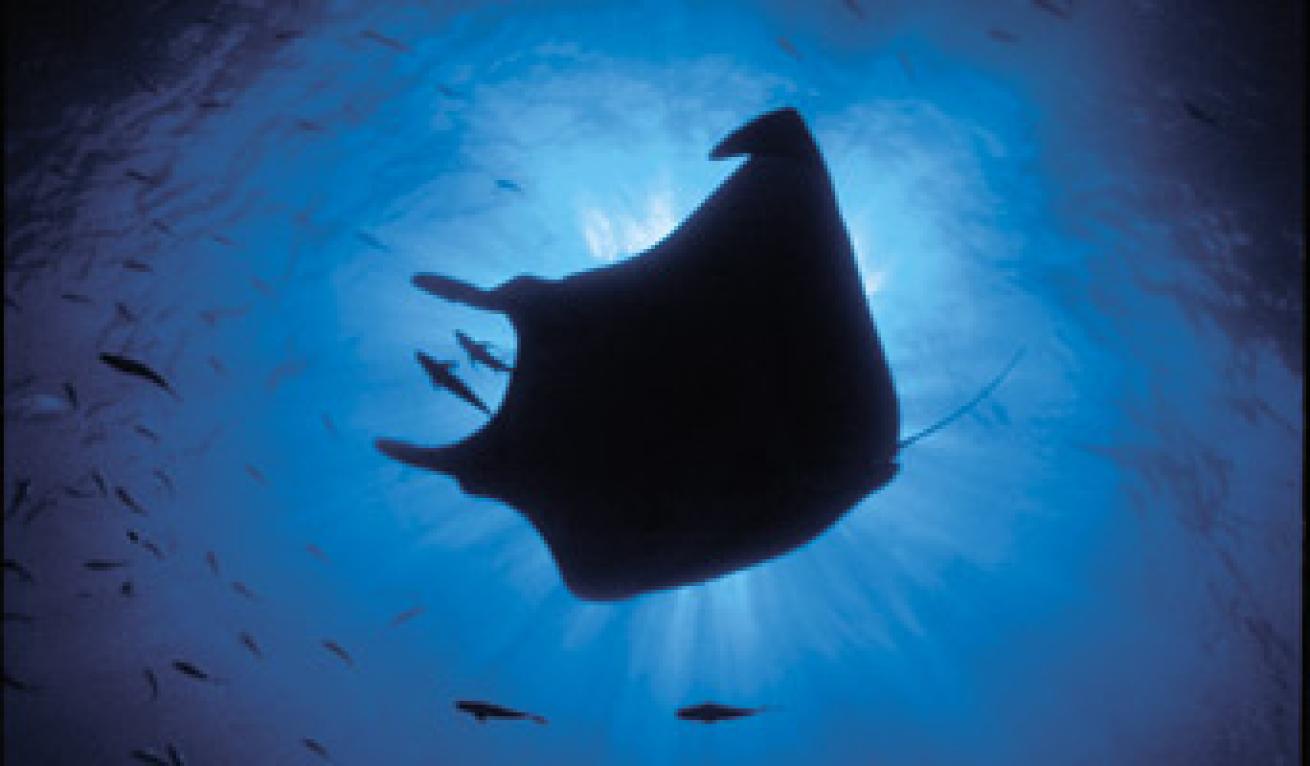
| |Mantas, often seen with wingspans greater than 15 feet, are the encounter of choice among divers traveling to Baja.|
Cross over the U.S. border below the California state line and you've entered the great Baja peninsula. It is a land of vast, dry desert studded with cardon cactus and pine-rich rock mountains. Heart-stopping underwater encounters await you on sites surrounding the many uninhabited wind-raked islands dotting the coastline. The plankton-rich currents of the Pacific along the western coast of California Sur and sheltered waters of the Sea of Cortez support whale sharks, dolphins, giant manta rays and schools of sharks such as scalloped hammerheads.
La Paz and Loreto on the southern interior and Los Cabos (Cabo San Lucas and San Jose Del Cabo) at the southern tip are the staging areas for expeditions to dive with the same sharks and rays that draw divers to exotic locales like Cocos Island and the Galapagos. Out in the deep, 220 miles southwest of Cabo, the Socorro island chain, also known as Islas Revillagigedo, is an uninhabited archipelago that offers tremendous diving on its lava-forged flanks.
Loreto
Midway up the east coast of the peninsula, Loreto sits perched in the shadow of the Sierra Giganta mountains. The town of 10,000 is little more than a sleepy, seaside community, but divers have long boarded boats headed to the nearby islands of Coronado, Carmen, Danzante, Monserrate and Catalan. Like most of these island sites, the marine habitat encompassing them was protected by the designation of the Parque Maritimo Nacional Bahia de Loreto in 1997.
The underwater cliffs of Los Candelleros, a triad of rocky mounts to the east of Danzante, drop precipitously to a rocky bottom at 200 feet.
Down for 20 years, the 120-foot tuna boat in Bahia Salina Bay rests at 35 feet near the site of Carmen's now defunct salt plant. Out in Escondido Bay, Punta Coyote is a quick panga ride from shore. The rock bottom is strewn with boulders, most with settlements of sea fans, gorgonians and their attendant schools of balloonfish.
|| |---|
|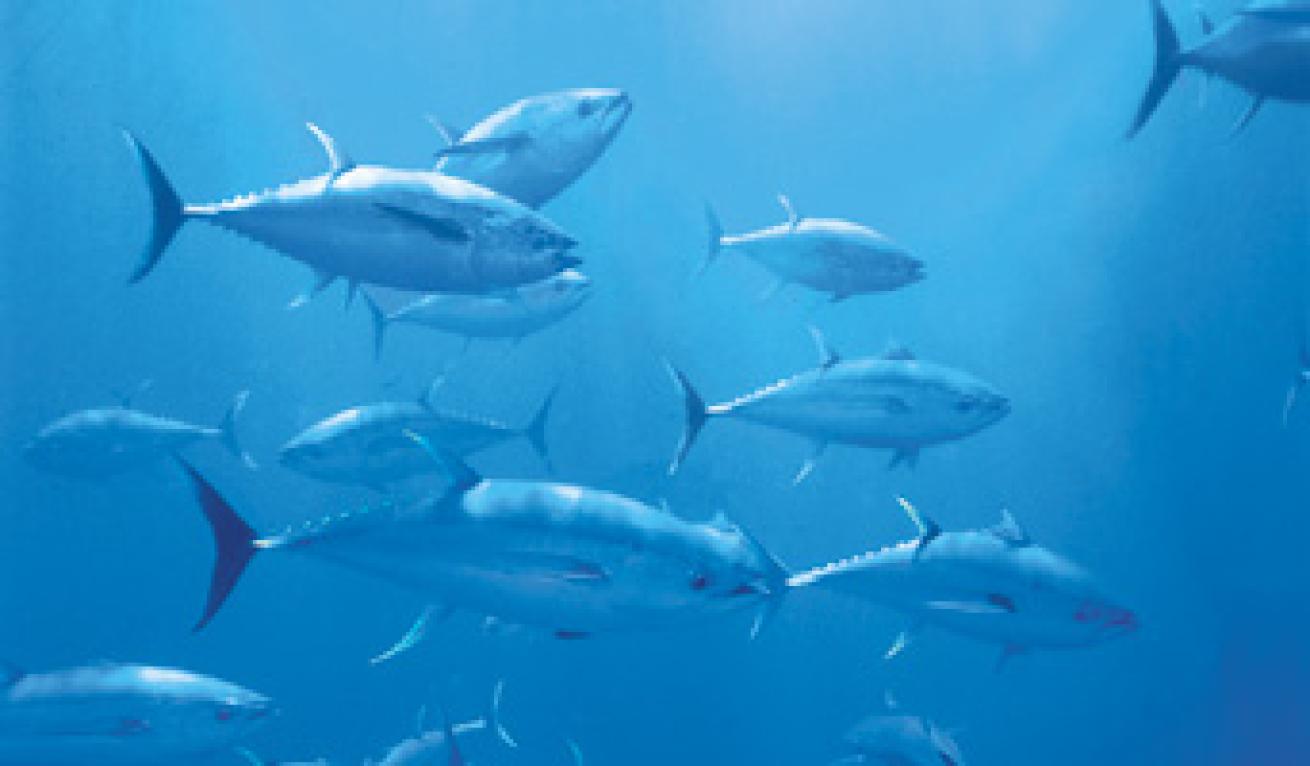
| |Yellowfin tuna are often found schooling at offshore seamounts in the Sea of Cortez and at sites surrounding the Socorro Islands.|
La Paz
A favorite beach destination of Mexicans, La Paz, hub of Baja eco-tourism, affords some of the best diving in the Sea of Cortez. There is a diversity of options: a shipwreck dive, a chance to swim alongside sea lions and the likelihood of shark encounters at the seamounts.
The 300-foot-long ferry Salvatierra became an artificial reef by accident, grounding on Swanee Rock in San Lorenzo channel in 1975. Cargo, like the trucks that were en route from La Paz to Topolobampo, rest alongside the former World War II transport ship at 60 feet. Cortez angelfish, jewel morays and groupers are common not far from her still-intact props.
With her backdrop of sharp monolithic rocks, Los Islotes, on the north side of Isla Partida, has been colonized by sea lions. An archway cut through the island on the eastern end is a popular night dive, rife with cocooned parrotfish, king angelfish and billowing orange cup corals.
Rising up to within recreational limits, the Pinnacles and Seamount of Las Animas as well as El Bajo Seamounts attract schooling jacks, tunas and hammerheads. Boat trips are not quick jaunts, so operators favor making a two-tank outing a day trip with lunch.
Socorro Islands
The volcanic chain of Socorro, San Benedicto, Roca Partida and Clarion islands is reachable only by live-aboards and other vessels capable of handling the 24-hour crossing from Cabo. Strong currents, plankton-rich upwellings and underwater promontories characterize the diving in this protected string of islands.
November through June is the optimal dive season thanks to the most manageable conditions, but currents and surge are common even then. While visibility can top 100 feet, pockets of plankton can cloud the water.
With drum-beating wings, giant mantas glide through the waters surrounding Benedicto's seamounts like the Boiler. Galapagos, silvertip, silky and hammerhead sharks frequent Bruce's Site, a seamount on the eastern side of Benedicto in full view of her volcanic cone.
Along with San Benedicto, Socorro, centerpiece of the islands, is a southerly reference point along the spring humpback migration. Less imposing than these great mammals, creatures like clarion angelfish, redtail triggerfish and Moorish idols appear at Socorro sites between Double Pinnacle and North End.
|| |---|
|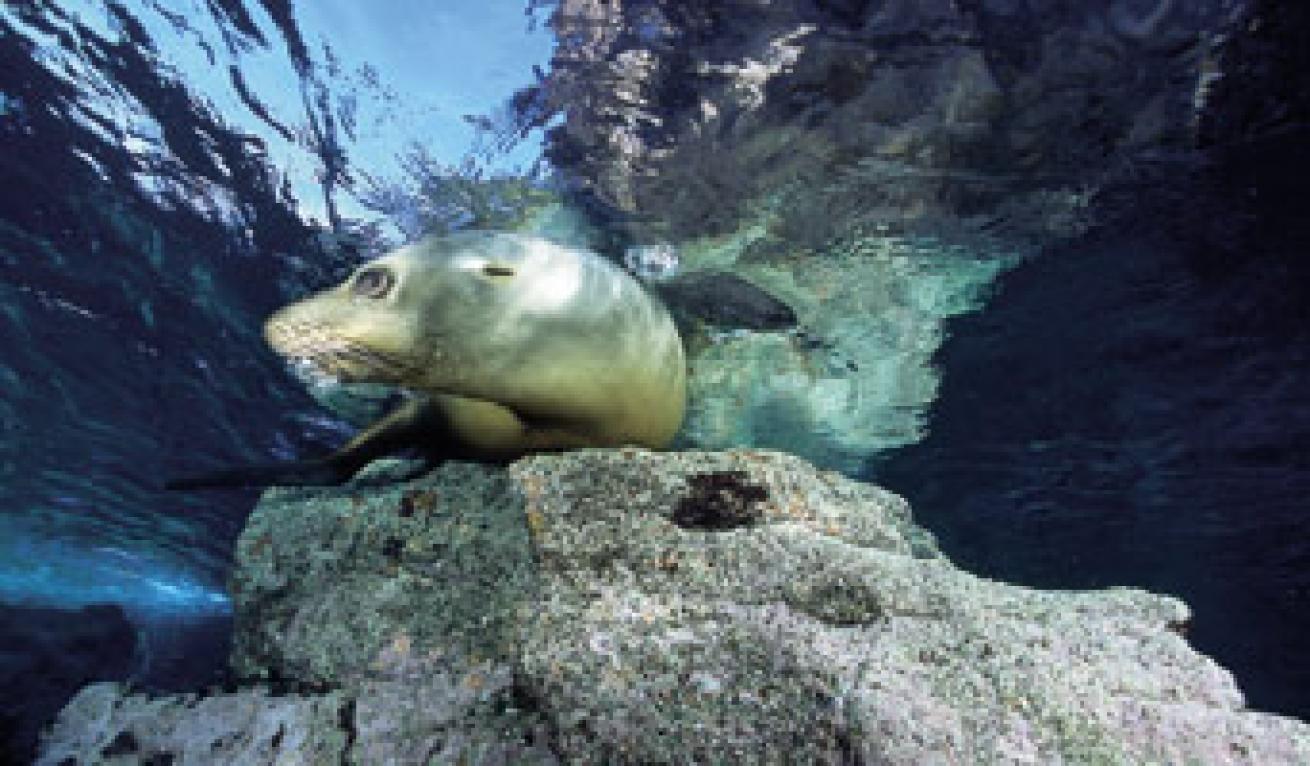
| |Rocky islands like Los Islotes off La Paz and Pinnacle off Los Cabos have been adopted by colonies of sea lions because of the abundance of fish life.|
Los Cabos
|| |---|
|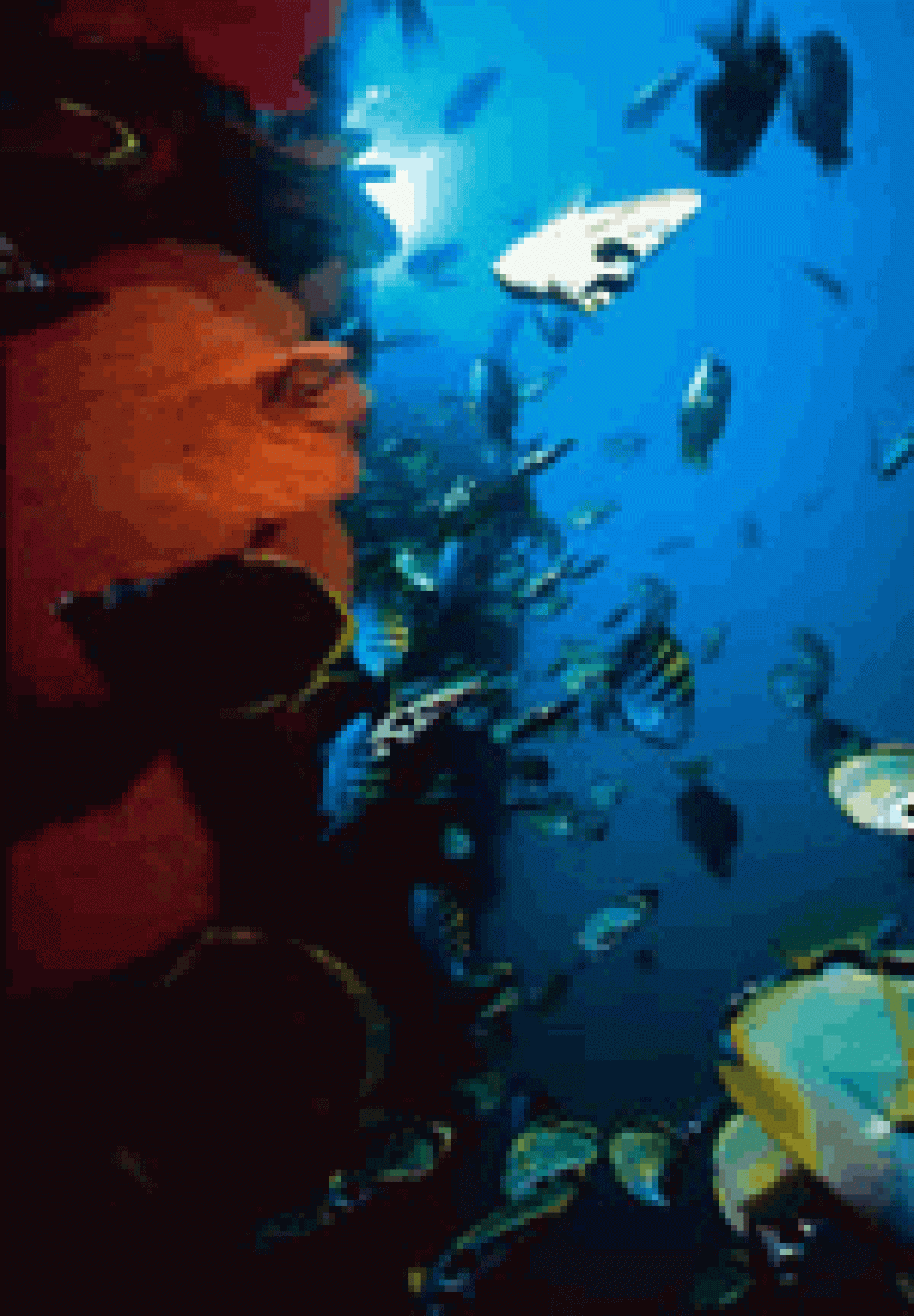
| |Schools of Panamic sergeant majors and barberfish intermingle on a Baja reef.|
Don't allow the beachfront high-rises and boomtown atmosphere of Cabo San Lucas and San Jose Del Cabo color your impression of the diving. There is much to be seen here in addition to the barren rocks of the Land's End arches where the Sea of Cortez commingles with the cold Pacific.
Credit Jacques Cousteau with the discovery of Sand Falls, a barren plain at 90 feet where sands shift over a rock wall. Nearby Anegada Rock, which the boats pass en route to Sand Falls, is the year-round residence of a sea lion colony. Farther north in the Bay of San Lucas, a similar rookery of sea lions has adopted a rocky mount called Pinnacle.
On shore, a blowhole sends a spray of water shooting skyward from the rocks. Offshore, the dive site Blowhole features several walls and caves sloping from 40 to 100 feet.
Experienced divers will prefer a trip five to eight miles out to Gorda Banks, a seamount that tops out at 130 feet. Moray eels hide in fronds of black coral while hammerheads, mantas and occasionally whale sharks cruise the currents.
Considered the northernmost living coral reef in the Pacific, the cluster of four separate reefs known as Cabo Pulmo were forged from the ground up by polyps. At 20 to 70 feet, this shallow reef and its surrounding waters harbor 220 species of fish. Boats from Cabo take approximately two hours to reach the site.
Dive In
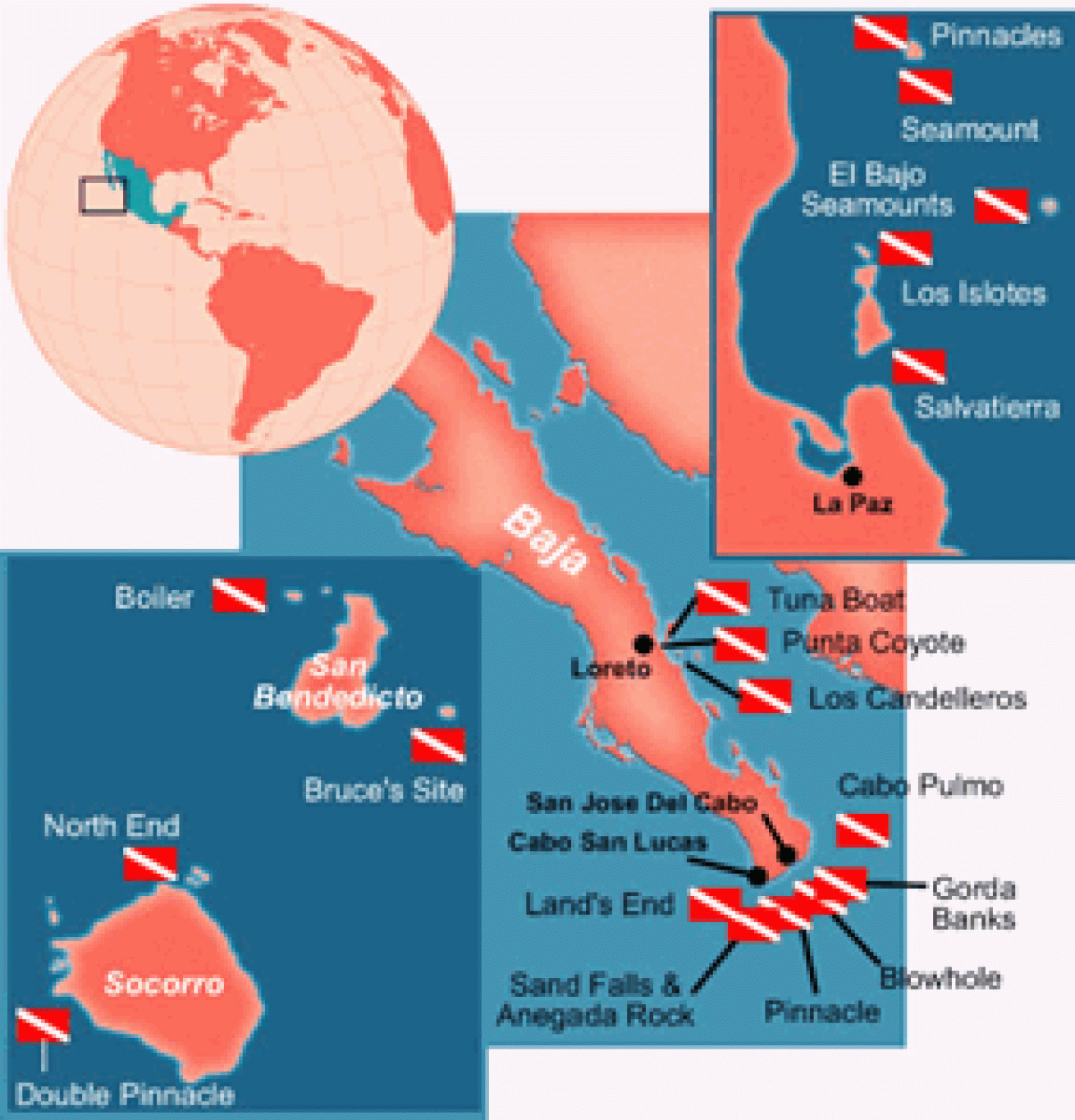
Getting there: International airports at San Jose Del Cabo and La Paz are served by a number of U.S. and international airlines. Transpeninsular Highway 1 is the ticket for the drive south.
Getting around: Cabs, shuttle vans and rental cars are readily available in major cities.
Accommodations: Run the gamut from top-dollar resorts to local hotels, RV parks and primitive campgrounds.
Weather: Temperatures can soar to 110F in summer, but the average is more like 95F. In the winter, expect daytime highs in the low 70Fs. The sky is usually cloudless and the sun intense, so don't forget the sunscreen.
Water Conditions: There is year-round diving in the Sea of Cortez off Baja Sur, but the best time is late June to early November. The absolute best months are September and October, when the seas are flat, visibility peaks at 60 feet or more and surface temperatures hit a toasty 85F. It's still cold enough below the thermocline that most divers opt for full 3mm wetsuits.
In winter, surface water temperatures drop to 65 to 70F, so you'll need a 5mm or 6mm full wetsuit with hood and gloves. Seas can kick up to two to three feet, and vis drops to an average of 30 to 50 feet due to plankton blooms. On the plus side, gray whales and occasionally blue whales move into the sea in winter to feed and mate, increasing your chances of an encounter.
Electricity: 110 volts, 60 cycles. Not all facilities have U.S.-style three-pronged plugs, so you may need adapters.
Telephone: To reach Baja, you'll need to dial 011-52, followed by the local three-digit area code and the five-digit number.
Documents: Passport. You'll be issued a tourist visa good for 180 days by Mexican immigration on arrival. There is also a departure tax.
Money Matters: The Mexican peso is the official currency, though U.S. dollars are widely accepted in tourist businesses and larger cities. Traveler's checks and credit cards are also accepted at resorts, restaurants and dive shops. You will need pesos for small purchases, gas stations and merchants in outlying areas. At press time, the official exchange rate was US$1 to MXP9.23.
Just In Case: There is a recompression chamber in Cabo San Lucas that's on call 24 hours a day.

